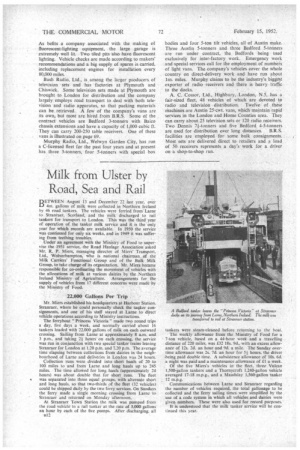Milk from Ulster by Road, Sea and Rail
Page 46

If you've noticed an error in this article please click here to report it so we can fix it.
BETWEEN August 13 and December 22 -last year. over 4m. gallons of milk were collected in Northern Ireland by 46 road tankers. The vehicles were ferried from Larne to Stranraer, Scotland, and the milk discharged to rail tankers for transport to London. This was the third year of operation of the tanker milk service and it is the only year for which records are available. In 1950 the service was continued for only six weeks, and in 1949 it was suffering from teething troubles.
Under an agreement with the Ministry of Food to supervise the 1951 service, the Road Haulage Association asked Mr. R. P. Miers, managing director of Miers' Transport, Ltd., Wolverhampton, who is national chairman of the Milk Carriers' Functional Group and of the ,Bulk Milk Group, to take charge of its organization. Mr. Miers became responsible for co-ordinating the movement of vehicles with the allocations of milk at various dairies by the Northern Ireland Ministry of Agriculture. Arrangements for the supply of vehicles from 17 different concerns were made by. the Ministry of Food.
22,000 Gallons Per Trip Mr. Miers established his headquarters at Harbour Station, Stranraer, where he could personally check the tagker consignments, and one of his staff stayed at Larne to direct vehicle operations according to Ministry instructions.
The ferryboat "Princess Victoria" made two round trips. a day, five days a week, and normally carried about 16 tankers loaded with 22,000 gallons of milk on each outward crossing. Sailing from Lame at approximately 8 a.m. and 3 p.m., and taking 21 hours on each crossing, the service was run in conjunction with two special tanker trains leaving Stranraer for London at 1.20 p.m. and 7.20 p.m. The average time elapsing between collections from dairies in the neighbourhood of Larne and deliveries in London was 24 hours.
collection runs were divided into short hauls of 20 to 100 miles to and from Larne and long hauls up to 245 miles. The time allowed for long hauls (approximately 24 hours) was about double thai for short. runs. The fleet was separated into three equal groups, with alternate short and [Ong hauls, so that two-thirds of the fleet (32 vehicles) could be shipped daily by the two ferry services. On Sundays the ferry made a single morning crossing from Larne to Stranraer and returned on Monday afternoon.
At Stranraer Town Station the milk was pumped from the road vehicle to a rail tanker at the rate of 3,000 gallons an hour by each of the five pumps. After discharging, all tankers were steam-cleaned before returning to the boat.
• The weekly allowance from the Ministry of Food for a 7-ton vehicle, based on a 44-hour week and a travelling distance of 220 miles, was £32 18s. 9d., with an excess allowance of 12s. 2d. an hour and 9d. a mile. The Sunday. overtime allowance was 2s. 7d. an hour for 51 hours, the driver -being paid double time. A subsistence allowance of 10s. 6d. a night was paid and a maintenance allowance of LI a week. . Of the five Miers's vehicles in the fleet, three Vulcan I,500-gallon tankers and a Thornycroft 1,240-gallon vehicle averaged 17-18 m.p.g., and a Maudslay 1,560-gallon tanker 12 m.p.g.
Communications between Larne and Stranraer regarding the number of vehicles required, the total gallonage to be collected and the ferry sailing times were simplified by the use of a code system in which all vehicles and dairies were given numbers. These were also used for record purposes.
It is understood that the milk tanker service will be continued this year.




















































































